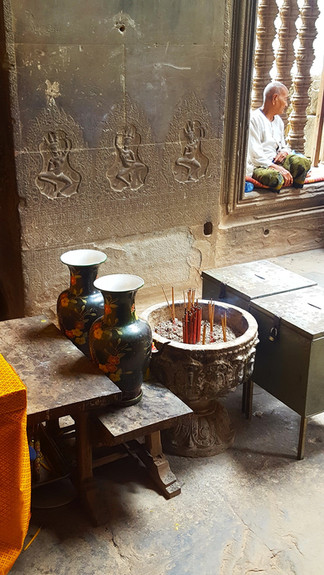Echoes of an Empire - The Sacred Ruins of Angkor Wat
- Shannon
- May 13
- 3 min read
Earning its rightful place on the UNESCO World Heritage Site list in 1992, Angkor Wat is the largest religious monument on the planet and one of the most important archaeological sites in South-East Asia. Commissioned in 1122AD by King Suryavarman II as a grand tribute to Vishnu, it was a bold deviation from the prevailing Shiva worship of the time. Suryavarman intended it not only as the capital of the ancient Khmer empire and a place of worship but as a funerary temple for his own soul. Aligning the entire structure to the west, it faces the setting sun and the direction of death in Hindu cosmology.

Encompassing an area of about 400 hectares, an astonishing five million tonnes of sandstone was used to build this colossal monument. Construction is believed to have spanned some three decades and involved an estimated 5000 stone carvers, workers and slaves. Surrounded by a massive 600 foot wide moat, the ancient megacity is laid out to represent Mount Meru, the mythical home of the gods. With elegant spires of ancient stone soaring towards the heavens, the central towers symbolise the peaks of Mt. Meru. The outer wall represents the edge of the universe and the moat symbolises the cosmic oceans within the Hindu universe.
Angkor Wat features an estimated 1200 square metres of bas-reliefs depicting armies on the march, gods locked in eternal battle and kings receiving divine blessings. There are over 3000 carvings of Apsaras (celestial nymphs) alone. The crown jewel of these carvings is called the “Churning of the Ocean of Milk,” a sprawling narrative etched along the east gallery. Here, a mountain rests on the back of a tortoise incarnation of Vishnu, while gods and demons pull a serpent back and forth, churning the cosmic sea in pursuit of amrita, the nectar of immortality.

A small section of the "Churning of the Ocean of Milk". This prominent bas-relief measures 49 metres long
Angkor Wat doesn’t have a fixed room count, but it’s estimated to have over 1000 chambers and passageways throughout its vast layout. The temple is designed with a series of rectangular galleries stacked concentrically, getting higher as they move toward the centre. These galleries create long, vaulted hallways and enclosed courtyards, connected by staircases, causeways and narrow doorways. Many of the “rooms” are open-air or semi-enclosed, used for processions or meditation.

Following King Suryavarman II's death around 1150 AD, the kingdom fell into a period of internal turmoil. In 1181, after a fierce battle, a young Jayavarman VII assumed the throne and continued extensive construction within the walled city. As time passed, Jayavarman VII set in motion the religious tide that would wash over Angkor Wat, slowly transforming the temple from a Hindu sanctuary to a Buddhist monastery, mirroring the religious evolution of Cambodia itself.

Apsaras are celestial nymphs or dancers who inhabit the heavenly realms and are associated with pleasure, beauty, music & dance. They are usually paired with "Gandharvas" who are the divine musicians of the heavens

During the course of the 16th century, Angkor was temporarily neglected again but was never fully abandoned. The ruins were rediscovered by the French in 1861 and the mammoth task of restorations commenced around 1898. This screeched to a halt in the 1970s and 1980s during Pol Pot's civil war but resumed again in the 1990's. It has experienced consistent conservation efforts ever since and is considered one of the seven wonders of the world.
Location : Angkor Archaeological Park, Angkor Wat, Siem Reap Province, Kingdom of Cambodia
How to get there : Angkor Wat lies 5.5 km north of Siem Reap and is included on all tours within the area. A tuk tuk driver can get you around for between $30-$50 USD per day.
Attraction Info : Admission is included with the Angkor temple pass. Entrance fees are structured to accommodate various itineraries. A 1-day pass is $37USD, a 3-day pass is $62USD and a 7-day pass at $72USD. Tickets can be purchased at the official Angkor Ticket Office or online. Generally 3 days is sufficient time to explore the area. The park grounds are open between 7:30am - 5:30pm however Angkor Wat opens between 5-5:30am to allow access to watch the sunrise. Be mindful the area will be packed with tourists at that time.
អង្គរវត្ត
Official Website : https://www.angkorenterprise.gov.kh/
Thanks for reading Echoes of an Empire - The Sacred Ruins of Angkor Wat, Check out more destinations here!























